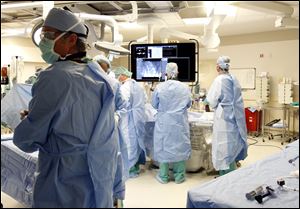
Robotic-assisted surgery offers women new option
Women can choose minimally invasive procedure
12/25/2012
The surgical team at ProMedica Toledo Hospital perform a minimally invasive procedure. Using a highly specialized robotic and computer-integrated surgical system known as da Vinci, gynecologists now can perform surgeries that are less invasive and offer a number of advantages to patients.
For many women struggling to cope with endometriosis, excessive bleeding, fibroid tumors, or other gynecologic health issues, surgery is often their last resort for treatment.
For years, however, traditional or “open” surgery options meant large incisions and long recovery times. Today, new advances in minimally invasive, robotic-assisted surgery have dramatically altered women’s surgical options.
Patient benefits
Using a highly specialized robotic and computer-integrated surgical system known as da Vinci, gynecologists now can perform surgeries that are less invasive and offer a number of advantages to patients. For example, what was once a multi-day stay in the hospital and six weeks of recovery time can now be an overnight stay and just two or three weeks of downtime for women facing surgery for gynecological conditions.
Additionally, open surgery can come with significant pain, discomfort and extended time away from normal daily activities. Surgery using the da Vinci Surgical System typically means much less pain following the procedure as well as reduced blood loss, minimal scarring and fewer post-surgical complications.
While every patient must be evaluated on an individual basis, there are few barriers to using robotic-assisted surgery. In fact, the technology often improves outcomes because it can be used with obese patients as well as women who have already had other surgeries such as multiple cesarean sections or prior pelvic surgery such as removal of ovary or cysts.
How it works
The da Vinci Surgical System is not an automated robot at all. Rather, da Vinci allows surgeons to work remotely by controlling the robotic arms attached to the micro-instruments from a console a few feet from the operating table. The surgeon’s hand movements are used to precisely guide the robotic arms to twist, turn and rotate during an operation, giving doctors greater precision and control.
Additionally, the delicate movements available with the da Vinci system allow a greater range of access within the body. A three-dimensional binocular-like camera lens, attached to a scope routed through a tiny incision, magnifies the view up to 10x that of the naked eye. This allows surgeons to see even the smallest of details within a fraction of a millimeter.
Currently, the most common da Vinci procedure is hysterectomy, followed by surgical resection of endometriosis. In the past, a large percentage of hysterectomies were open surgeries. Today, that number has been greatly reduced thanks to improved surgical methods and technology. And for young women with endometriosis, resection involves removal of endometrial tissue implants while leaving the uterus and ovaries in place. This type is normally recommended for women who wish to maintain fertility.
Other common gynecology procedures using da Vinci include myomectomy – the removal of noncancerous uterine fibroids – and abdominal sacrocolpopexy – connecting the vaginal wall to the bone at the base of the spine when muscles or ligaments allow the vagina to drop. Your doctor can provide the best guidance on treatment and surgical options for your specific health concerns.
Dr. Bishop is a board-certified gynecologist with ProMedica Physicians in Toledo. For more information, please visit www.promedica.org.